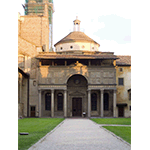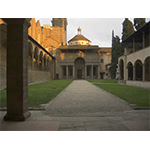Complesso Monumentale di Santa Croce [Monumental Complex of Santa Croce]
Construction of the church of Santa Croce began in 1295 on the site of a pre-existing Franciscan church. The religious centre became the hub of spiritual, social, productive and cultural life of the entire district. The church became an extraordinary melting pot where artists like Giotto, Donatello and Brunelleschi worked. The presence of funerary monuments of illustrious personages, including several scientists, makes Santa Croce the "pantheon of the Italians", celebrated by Ugo Foscolo in his Sepolcri.
After the death of Galileo Galilei (1642), his remains were placed in a little room beneath the bell tower of the church of Santa Croce, adjoining the Chapel of Saints Cosma and Damiano, while awaiting the construction of a monumental sepulchre. The project, however, encountered the hostility of church authorities who pointed out to Grand Duke Ferdinando II de’ Medici the inopportuneness of erecting a monument to a man condemned by the Church. In 1632 in fact, Galileo had published in Florence his Dialogo sopra i due massimi sistemi del mondo [Dialogue Concerning the Two Chief World Systems], an overtly Copernican work. The Dialogue had been sequestered and the scientist summoned to Rome by the Holy Office. The trial ended with the condemnation of Galileo who was forced to abjure and «quit the false opinion that the sun is the centre of the world and that it does not move, and that the earth is not the centre of the world and that it moves». Despite opposition, the youngest disciple of the Pisan scientist, Vincenzo Viviani, devoted enormous energy to the project for a monumental sepulchre. A worthy tribute to the scientist would have permitted the total recovery of Galilean thought in the official cultural debate. Viviani, however, did not succeed in surpassing the resistances of ecclesiastic environments. Only at the end of the reign of Giangastone de’ Medici, almost a century after Galileo’s death, was it possible to inaugurate the monumental sepulchre. On March 12, 1737, the mortal remains of Galileo and Viviani, along with an unexpected third body, of a woman, probably Galileo’s beloved daughter Suor Maria Celeste, were carried in a procession from the first burial site to the new sepulchre. The sculptural layout presents an iconographic apparatus that alludes to the Pisan scientist’s greatest intuitions. On either side of the urn are the statue of Geometry, sculpted by Girolamo Ticciati, which celebrates Galilean studies on the inclined plane and on falling bodies, and that of Astronomy, the work of Vincenzo Foggini, which shows the Galilean discovery of sun spots. The sepulchre is surmounted by a bust of Galileo holding a telescope in hand. Above the monument, the coat of arms of the Galilei family.
Inside the basilica, among tens of sepulchres of eminent personalities in every field of human activity (from Michelangelo to Vittorio Alfieri, from Gioacchino Rossini to Ugo Foscolo), we also find those of Fossombroni (a decisive figure in the complex reclamation of Maremma, carried out by Leopold II), Eugenio Barsanti, co inventor with father Felice Matteucci, of the first prototype of the internal combustion engine (the engine utilised the internal combustion of gases to produce motive power), and of physicist Leopoldo Nobili.
The monumental complex of Santa Croce is a significant place for science also for the astronomical fresco in the Pazzi Chapel, designed by Brunelleschi, that portrays a nocturnal sky, similar to the one in the Old Sacristy of San Lorenzo.
****************************
Texts by Graziano Magrini
English translation by Victor Beard
Last update 22/apr/2008





